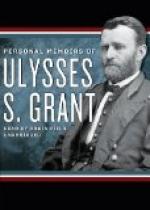On the 30th of January, the day after my arrival at the front, I ordered General McPherson, stationed with his corps at Lake Providence, to cut the levee at that point. If successful in opening a channel for navigation by this route, it would carry us to the Mississippi River through the mouth of the Red River, just above Port Hudson and four hundred miles below Vicksburg by the river.
Lake Providence is a part of the old bed of the Mississippi, about a mile from the present channel. It is six miles long and has its outlet through Bayou Baxter, Bayou Macon, and the Tensas, Washita and Red Rivers. The last three are navigable streams at all seasons. Bayous Baxter and Macon are narrow and tortuous, and the banks are covered with dense forests overhanging the channel. They were also filled with fallen timber, the accumulation of years. The land along the Mississippi River, from Memphis down, is in all instances highest next to the river, except where the river washes the bluffs which form the boundary of the valley through which it winds. Bayou Baxter, as it reaches lower land, begins to spread out and disappears entirely in a cypress swamp before it reaches the Macon. There was about two feet of water in this swamp at the time. To get through it, even with vessels of the lightest draft, it was necessary to clear off a belt of heavy timber wide enough to make a passage way. As the trees would have to be cut close to the bottom—under water—it was an undertaking of great magnitude.
On the 4th of February I visited General McPherson, and remained with him several days. The work had not progressed so far as to admit the water from the river into the lake, but the troops had succeeded in drawing a small steamer, of probably not over thirty tons’ capacity, from the river into the lake. With this we were able to explore the lake and bayou as far as cleared. I saw then that there was scarcely a chance of this ever becoming a practicable route for moving troops through an enemy’s country. The distance from Lake Providence to the point where vessels going by that route would enter the Mississippi again, is about four hundred and seventy miles by the main river. The distance would probably be greater by the tortuous bayous through which this new route would carry us. The enemy held Port Hudson, below where the Red River debouches, and all the Mississippi above to Vicksburg. The Red River, Washita and Tensas were, as has been said, all navigable streams, on which the enemy could throw small bodies of men to obstruct our passage and pick off our troops with their sharpshooters. I let the work go on, believing employment was better than idleness for the men. Then, too, it served as a cover for other efforts which gave a better prospect of success. This work was abandoned after the canal proved a failure.




